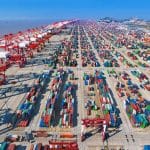GPA EXTENDS TRUCK HOURS AMID GROWING VESSEL BACKLOG
The Port of Savannah has more than 40 vessels anchored outside its harbor, but the Georgia Ports Authority said the terminal is more fluid today than last fall.
TERMINAL APPOINTMENTS ADD TO NY-NJ EMPTY RETURN HURDLES
Port of New York and New Jersey drayage carriers say their ability to operate is being hamstrung by the need to find scarce appointments at marine terminals for returning empties.
LANDSIDE BOTTLENECKS LIMITING WEST COAST MARINE TERMINAL CAPACITY
West Coast port managers say their terminals could handle even more vessel capacity than trans-Pacific carriers are scheduled to deploy this peak season, but landside bottlenecks are limiting the effective terminal capacity that exists today.
PHILAPORT READIES OCEAN TERMINAL FOR MORE BOXES AS ASIA SERVICE LAUNCHES
The Port of Philadelphia is prioritizing the densification of the Packer Avenue Marine Terminal and looking to open new near-dock storage as it readies for post-Panamax ship calls.
GEORGIA, SOUTH CAROLINA PORTS URGE OCEAN CARRIERS TO END SKIPPING CALLS
Officials in Savannah and Charleston want carriers to stop changing port calls because unexpectedly discharging containers in the other’s port causes landside woes and disrupts the overall supply chain.
PARTIES IN WEST COAST PORT LABOR NEGOTIATIONS REPORT PROGRESS ON HEALTH BENEFITS
Parties involved in the U.S. West Coast port labour talks have announced a tentative agreement on health benefits as negotiations on other issues continue in overtime.
The International Longshore and Warehouse Union (ILWU), representing longshore workers, and employers represented by the Pacific Maritime Association (PMA) issued a joint statement on Tuesday announcing the tentative deal on what the statement described as “an important part of the contract.”
The labour contract being negotiated covers more than 22,000 longshore workers at 29 U.S. West Coast ports. The previous agreement expired on July 1 and negotiations, which kicked off May 10, are continuing without a contract extension. Both sides have promised to keep cargo moving and maintain normal operations during the negotiations, recognizing the strategic importance of the ports to the economy.
Details regarding the tentative agreement related to maintenance of health benefits (MOB) are not being released. In fact, neither party is releasing any details related to the negotiations with the exception of period joint statements. Uncertainty surrounding the negotiations have contributed to more vessels shifting calls to U.S. East and Gulf Coast ports, like the ports of New York, Savannah and Houston, where cargo volumes have surged to new records.
PORT OF SAVANNAH BACKUP SWELLS AS SHIFTING TRADE AND AD HOC SERVICES CONTRIBUTE TO CARGO SURGE
Port of Savannah’s ship backup continues to build as a shift in vessel calls from the West Coast, Charleston diversions, and growing number of ad hoc and new services led the port to its busiest June on record.
Georgia Ports Authority (GPA) reported record cargo volumes in June at the Port of Savannah, the second-busiest port on the East Coast and fastest-growing in the nation. June’s volumes close out Savannah’s fiscal year with 5.76 million twenty-foot equivalent container units (TEU), up 8 percent compared to FY2021.
The Port of Savannah experienced a record June, handling 494,107 TEUs, up 10.6 percent or 47,300 TEUs compared to the same month last year. June’s cargo volumes follow Savannah’s busiest month ever in May and third-busiest month on record in April.
“As the hub in a global network of road, rail and ocean carrier connections, our ports link Georgia businesses to international trade lanes and open doors to prosperity for our state and nation,” said Georgia Gov. Brian Kemp. “The Georgia Ports Authority and its partners in the logistics industry are powerful drivers for local economies across the Peach State, from small communities to our thriving urban centres.”
The port authority said that in addition to organic growth, Savannah trade has also been boosted by West Coast labour talks and delayed access to rail at West Coast ports, prompting a significant shift in vessel calls. It is also receiving container trade diverted from the Port of Charleston.
SHIP BACKUP
GPA said it is currently handling the highest volume of ad hoc and new service vessels the Port of Savannah has experienced to date. “Uncertainty around the labour talks, unprecedented and unplanned vessel calls, record cargo volume, and vessel diversions to Savannah have contributed to a higher-than-normal number of vessels waiting at anchor,” the GPA said in its update.
The backup of ships waiting at anchor off Savannah has swelled in recent months, growing from the single digits in May to 43 currently, surpassing last September’s record number before the GPA took steps to alleviate congestion. By February the backup was eliminated.
“Despite the record volumes, the Port of Savannah remains fluid,” said GPA Executive Director Griff Lynch. “Several factors have contributed to our growing container capacity, including expedited infrastructure projects, our inland pop up yards and an influx of truck drivers moving to the Southeast.”
GPA is also reporting record truck turns during both its day and night-gate operations. Garden City Terminal saw a weekday average of 14,500 truck moves in June, counting both inbound and outbound gate exchanges.
PORT OF OAKLAND TERMINALS REOPENED AS TRUCKERS’ PROTEST MOVED TO NEW SITE
California’s Port of Oakland has fully resumed operations after truckers protesting a gig-work law blocked access for five days and disrupted the flow of goods at the key shipping hub. Terminals restarted operations over the weekend and cargo is now moving normally, the port said in a statement Monday. Still, it will likely take weeks to reduce the backlog created by the protests, said Robert Bernardo, a spokesman for California’s third-busiest port. The blockade led the port’s largest marine terminal, SSA Marine Inc., to shut down for at least three days last week, while three others closed for trucks at different points. About 450 dockworkers were unable to report to their job. The disruptions affected the shipping of goods including medical supplies, agricultural products, livestock and industrial parts, the port said. The protests are now being shifted to “free speech zones,” Bernardo said. The port’s executive director, Danny Wan, last week urged drivers to move to those newly designated areas and to “cease any further protest activity that disrupts port operations.”




